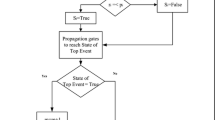Abstract
Mines systems such as ventilation system, strata support system, flame proof safety equipment, are exposed to dynamic operational conditions such as stress, humidity, dust, temperature, etc., and safety improvement of such systems can be done preferably during planning and design stage. However, the existing safety analysis methods do not handle the accident initiation and progression of mine systems explicitly. To bridge this gap, this paper presents an integrated Event Tree (ET) and Fault Tree (FT) approach for safety analysis and improvement of mine systems design. This approach includes ET and FT modeling coupled with redundancy allocation technique. In this method, a concept of top hazard probability is introduced for identifying system failure probability and redundancy is allocated to the system either at component or system level. A case study on mine methane explosion safety with two initiating events is performed. The results demonstrate that the presented method can reveal the accident scenarios and improve the safety of complex mine systems simultaneously.






Similar content being viewed by others
Abbreviations
- ET:
-
Event tree
- FT:
-
Fault tree
- HAZOP:
-
Hazard and operability study
- STEP:
-
Safety training and evaluation process
- PSA:
-
Probabilistic safety assessment
- MSS:
-
Mines safety system
- SB:
-
Safety barrier
- THP:
-
Top hazard probability
- ALARA:
-
As low as reasonably achievable
- IE:
-
Initiating event
- Ci :
-
ith consequence
- PCk :
-
Probability of Ckth consequences
- Si :
-
ith safety barrier
- λi :
-
ith failure rate
- Pi :
-
ith probabilities
References
P.K. Marhavilas, D. Koulouriotis, V. Gemini, Risk analysis and assessment methodologies in the work sites: on a review, classification and comparative study of the scientific literature of the period 2000–2009. J. Loss Prev. Process Ind. 24, 477–523 (2011)
U. S. Nuclear Regulatory Commission (1975) Reactor Safety Study, an Assessment of Accident Risks in U.S. Nuclear Power Plants. WASH-1400. U. S. Nuclear Regulatory Commission, Washington DC
H.W. Lewis, R.J. Budnitz, H.J.C. Kouts, W.B. Loewenstein, W.D. Rowe, F. von Hippel, F. Zachariasen, Risk Assessment Review Group Report to the U. S. Nuclear Regulatory Commission (U. S. Nuclear Regulatory Commission, Washington, 1978)
U. S. Nuclear Regulatory Commission, An Approach for Using Probabilistic Risk Assessment in Risk-Informed Decisions on Plant Specific Changes to the Licensing Basis (U. S. Nuclear Regulatory Commission, Washington, 1998)
G.E. Apostolakis, H. Dezfuli, S.D. Gahring, M.B. Sattison, W.E. Vesely, Report of the Independent Peer Review Panel on the Probabilistic Risk Assessment of the International Space Station (NASA Headquarters, Office of Safety and Mission Assurance, Washington, 2002)
R.J. Budnitz, G. Apostolakis, D.M. Boore, L.S. Cluff, K.J. Coppersmith, C.A. Cornell, P.A. Morris, Use of technical expert panels: applications to probabilistic seismic hazard analysis. Risk Anal. 18, 463–469 (1998)
J. Joy, D. Griffiths, National minerals industry safety and health risk assessment guideline (Minerals Council of Australia: Version 6, Sydney, 2007)
A. Badri, S. Nadeau, A. Gbodossou, Integration of OHS into risk management in an open-pit mining project in Quebec (Canada). Minerals 1, 3–29 (2011)
Ministry of Coal (MoC), Guidelines for preparation of mining plans for coal/lignite blocks, Ministry of Coal, Government of India, New Delhi, No. 34011/(48)/2009-CPAM (2009)
Ministry of Labour, Recommendations of 11th Conference on Safety in Mines. Ministry of Labour, New Delhi; http://www.dgms.net/Recommendation%20of%2011th%20safety%20conference,9.7.13.pdf (2013)
Bureau of Indian Standards (2012) Indian Standard on Electrical Apparatus for Explosive Gas Atmospheres. Part 0: General Requirements. Bureau of Indian Standards, New Delhi; IS/IEC 60079-0
CDC Statistics (2014) http://www.cdc.gov/niosh/mining/statistics/content/coaldisasters.html
F.N. Kissell, Handbook for Methane Control in Mining (National Institute for Occupational Safety and Health, Pittsburgh, 2006)
F.N. Kissell, G.V.R. Goodman (1991) Preventing tunnel methane explosions: What’s most important? In: Proceedings of the Fifth U.S. Mine Ventilation Symposium, Morgantown, USA, p 605–610
Author information
Authors and Affiliations
Corresponding author
Rights and permissions
About this article
Cite this article
Kumar, R., Ghosh, A.K. Mines Systems Safety Improvement Using an Integrated Event Tree and Fault Tree Analysis. J. Inst. Eng. India Ser. D 98, 101–108 (2017). https://doi.org/10.1007/s40033-016-0121-0
Received:
Accepted:
Published:
Issue Date:
DOI: https://doi.org/10.1007/s40033-016-0121-0




